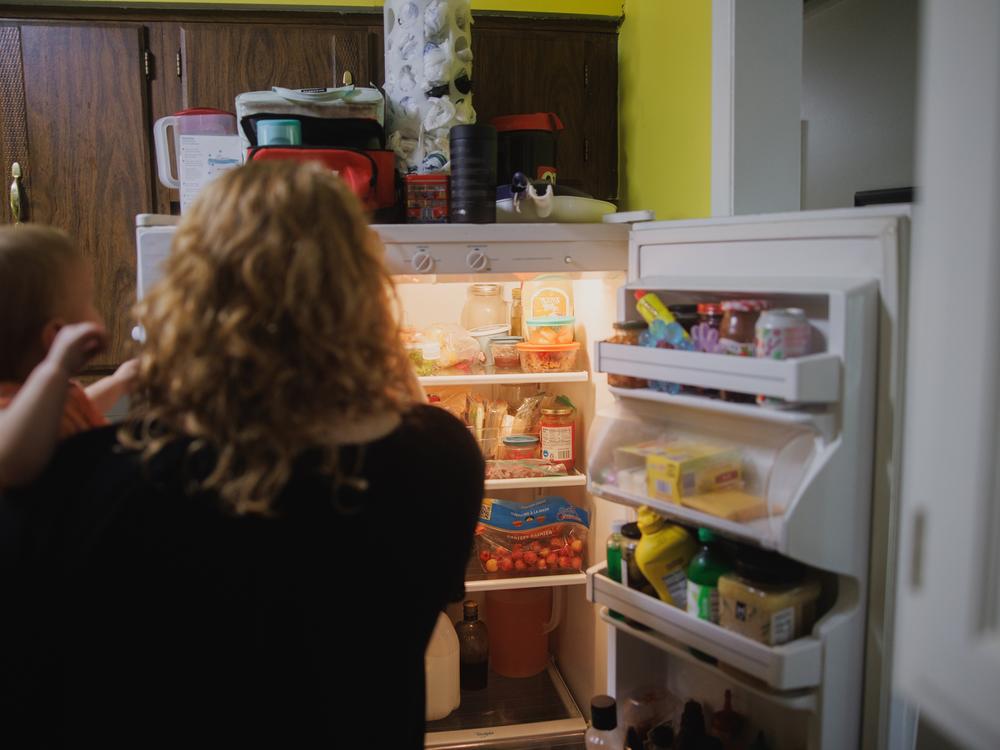Section Branding
Header Content
Sticker shock: How the supermarket has become a potent symbol of inflation in America
Primary Content
For Ellie Currence, every trip to the grocery store brings a moment of sticker shock.
"Everything is more expensive, which is a huge bummer because it's the essentials I need," says Currence, who lives in Belton, Mo., outside Kansas City. Currence's family has recently expanded: She and her husband now have 1-year-old daughter Annalise to provide for.
"Milk. Eggs. Bread. It's just hard. I work full time. My husband works full time. I feel like at this point, we're moving more towards survival mode, rather than thriving," she says.
She's not the only one. Many Americans are fed up with the high cost of feeding their families, even though grocery prices have largely leveled off in the last year.
That was one of the most common pain points NPR heard from listeners and readers this summer when we asked how inflation is affecting their families.
Take Cindy Seinar, who sounded off while driving to an Aldi supermarket in Lynchburg, Va.
“We want to make potato salad. But if you go to buy mayonnaise, it’s $6 a jar now," the retired autoworker says. "It just doesn’t feel right to me.”
The cost of rent, electricity and auto insurance have all risen faster than groceries in the last year. But it's often the supermarket where shoppers still feel the sting.
That's partly because the modest 1.1% increase in grocery prices over the last year comes on top of a 4.7% increase in the previous year and a whopping 12.2% jump the year before that.
Mayonnaise prices, for example, have surged 43% over the past three years, according to global research firm NIQ, also known as NielsenIQ.
“What consumers are reacting [to] and feeling is the cumulative effect of inflation," says food economist David Ortega at Michigan State University.
Loading...
Shoppers are also reminded of higher grocery prices every time they go to the store.
"Unlike other prices, we see and experience food prices on a weekly, if not more frequent, basis," Ortega says. "We buy food more often than we get a haircut or book a vacation or buy a car.”
Hunting for bargains — and the Heinz ketchup trick
Amanda Whitworth from Panama City Beach, Fla., was so alarmed by rising food prices two years ago, she took a second job stocking grocery shelves at a Target store three nights a week.
Whitworth enjoys the employee discount, shops for her own family during breaks and likes steering other customers to in-house bargains.
“If I hear a gasp, I’ll say, 'May I show you something comparable?'" Whitworth says, pointing shoppers to Target's private-label products, like a loaf of Market Pantry bread that sells for $1.39. "I’ve kind of always been that weirdo that would drive across town for cheaper green beans.”
That’s not weird anymore.
Many shoppers now actively search for ways to cut corners — choosing oatmeal over packaged cereal, substituting cheaper pork for pricey beef and switching to lower-cost store brands, even if that requires a little subterfuge.
Seinar's husband in Virginia, for example, says he'll only eat Heinz ketchup. So she came up with a plan.
"I bought Aldi ketchup and I put it back in the Heinz bottles, so he didn’t know," Seinar says with a chuckle.
Currence — the recent mom — switched her daughter to Sam's Club baby formula without a hiccup. However, discount diapers proved to be a disappointment.
"I found I was either ripping them or she was having blowouts or leaks. And we were going through so many more diapers that it wasn't cost-efficient to continue buying the off-brand," Currence says. She reluctantly switched back to Huggies.
Finding bargains takes time and effort, which is another hidden cost of inflation. Currence no longer brings her husband along to the grocery store. She says he's too much of an impulse buyer and shopping solo allows her to concentrate on the mental math required to get the best deals.
"I'm like, 'green grapes or red grapes?' This one is $2 cheaper, but the bag is 3 ounces less," Currence says. "It feels like grocery shopping, which is something I really used to enjoy, has become more of a chore."
There is a silver lining
Rising food prices are a particular challenge for low-income families, who typically spend a larger share of their money on groceries than better-off families do.
But there's some positive news.
Now that grocery prices are climbing more slowly, rising wages are gradually catching up. Average wages rose 3.9% in the 12 months ending in June — or about 3 1/2 times as fast as supermarket prices.
As a result, the average person now has to spend about the same number of hours working to fill a shopping cart as they did before the pandemic.
But that’s little comfort to shoppers who still grit their teeth with every trip through the checkout aisle.
"I know both of my sons and my daughters-in-law — everybody is working as absolutely hard as they can," Seinar says. "They are not farther ahead than my husband and I were 30 years ago."




